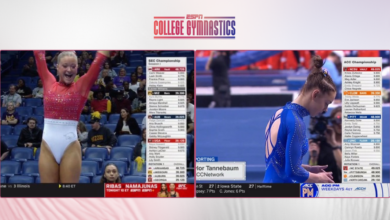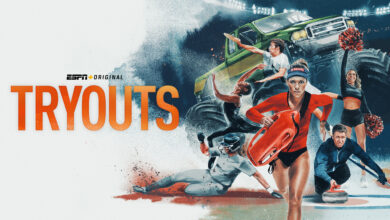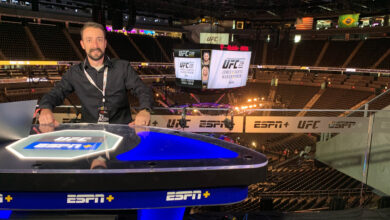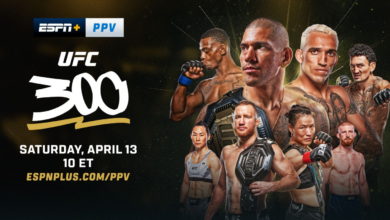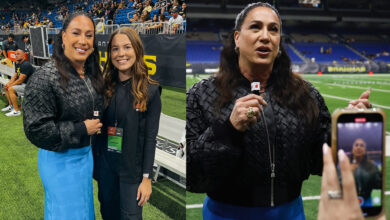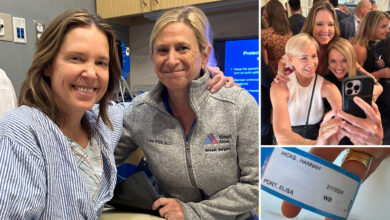Like a lot of us have discovered this week, working from home can be tough.
There are constant conference calls, video chats and email, all while trying to keep the dog quiet and the kids from killing each other.
Now try juggling those issues while producing one of the most popular shows on ESPN+.
Vice President, MMA Production, Glenn Jacobs’ team working on Ariel & the Bad Guy has that job on lock even while operating far from ESPN’s Bristol, Conn., studios.
Front Row checked in with two team members – producers Alisa Harrison and Nick Giangarra – who helped produce this week’s show using Bluejeans over home Wi-Fi.
The show will debut tonight on ESPN+. It’s an incredible effort and example of determination, creativity and teamwork, although there were some “challenges” with producing from home, as seen in the cold open for the show above.
How in the world do you produce a show like Ariel & the Bad Guy over Bluejeans?
NG: Glenn talked to us earlier this week and we all wanted to keep the show going despite everything going on. He had two primary requirements: 1) the show should still feel like our show, and 2) nobody was allowed to go to the office for any reason. Then we had to figure out how to do it, if it was even possible, but it was quite a vote of confidence from Glenn.
AH: As we were discussing ideas for how to do this, the most important aspect was keeping Ariel and Chael’s interaction and energy with each other, so a video chat system was the best way to go. We set up BlueJeans meetings to play around with th program and figure out the best way to do it.
Our managing producer, Sean Cooney, took the lead on setting it up to make sure we could record the conversation in a way that would work visually for our show’s dynamic.
What have you discovered are the most important elements of producing a show in this way?
AH: The heart of the show is the dynamic between Ariel and Chael, so preserving that was an important element. We also had to find ways to apply the show’s unique look in post-edit. Also, sharing the content and getting as many people from the team involved in the process was critical.
NG: The most important element honestly is teamwork. We’re all working on pieces of the show and then putting it together, so we all have to be on the same page. This production team has been together for years, so we have a solid group who knows how we each like to work. Also, the way Chael and Ariel bought in and worked with us as we’re all wandering into uncharted territory together, that was big!

What is the most challenging aspect?
AH: Normally we pre-plan and produce all video and graphic elements ahead of time, and we’re prepared to react and support Ariel and Chael’s discussion as it plays out. But we had to flip the workflow to a mostly post-edit process. Reversing the flow made the editing a much heavier lift on the parts of our team – like Alex Gonzalez, Kelsey Puckett and Brittany Cavanaugh – who produce and edit each section of the show.
NG: Since we’re all using our home internet connections to send clips back and forth it takes a lot longer than it would at the office. Getting fight video is challenging for the same reason. Back in the office it’s a simple media search, but now we have to take those files and drag them onto our computers with our home Wi-Fi connection. Not a speedy process!
How were you able to maintain the look and feel of the show?
NG: We definitely wanted to keep as much of the same look and feel of the show as possible, and I think we have done a pretty good job of that. Alisa worked with Chael and Ariel to keep them in the loop about what we wanted. I’m an editor at heart, so I designed a background template and lower thirds that are visually familiar to our fans. We also tracked down the transitions we use going into and out of fullscreens so those are exactly the same.
AH: Full credit to Nick on this on. He did a great job manipulating our show’s look and creating a template that worked with the BlueJeans double box look. The template he created made it possible for other members of the team to work on sections of the show, which made it a truly team effort.
Was there ever a doubt that you’d continue producing the show?
AH: I’d be lying if I said I didn’t have doubts. But our MMA team as a whole is a scrappy bunch, and we constantly find creative solutions and produce high volume content with a smaller staff, so this situation is really not that different. I’m proud and impressed by our team’s ability to come together and crush our goals!
NG: There was never a doubt that we wanted to produce the show. But until a couple days ago, we had absolutely no idea how it could be done, so there was some doubt there for sure. This team has had a lot of practice over the years creatively coming up with ways to produce content on our own. So once we got on the call and started throwing out ideas on how we could make this work, I was confident we would come up with something.
ESPN’s Daily Wager also is being produced out of commentators’ homes. Read more about ESPN’s innovative, expanding home and remote studio network.
